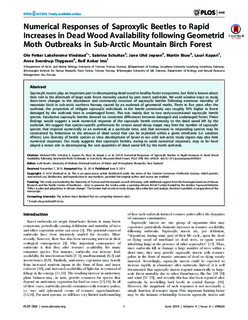| dc.contributor.author | Laksforsmo Vindstad, Ole Petter | |
| dc.contributor.author | Schultze, Sabrina | |
| dc.contributor.author | Jepsen, Jane Uhd | |
| dc.contributor.author | Biuw, Erik Martin | |
| dc.contributor.author | Kapari, Lauri Teemu | |
| dc.contributor.author | Sverdrup-Thygeson, Anne | |
| dc.contributor.author | Ims, Rolf Anker | |
| dc.date.accessioned | 2015-03-04T14:20:08Z | |
| dc.date.accessioned | 2017-01-20T12:09:10Z | |
| dc.date.available | 2015-03-04T14:20:08Z | |
| dc.date.available | 2017-01-20T12:09:10Z | |
| dc.date.issued | 2014 | |
| dc.identifier.citation | PLoS ONE 2014, 9(6) | nb_NO |
| dc.identifier.issn | 1932-6203 | |
| dc.identifier.uri | http://hdl.handle.net/11250/2427942 | |
| dc.description.abstract | Saproxylic insects play an important part in decomposing dead wood in healthy forest ecosystems, but little is known about
their role in the aftermath of large-scale forest mortality caused by pest insect outbreaks. We used window traps to study
short-term changes in the abundance and community structure of saproxylic beetles following extensive mortality of
mountain birch in sub-arctic northern Norway caused by an outbreak of geometrid moths. Three to five years after the
outbreak, the proportion of obligate saproxylic individuals in the beetle community was roughly 10% higher in forest
damaged by the outbreak than in undamaged forest. This was mainly due to two early-successional saproxylic beetle
species. Facultative saproxylic beetles showed no consistent differences between damaged and undamaged forest. These
findings would suggest a weak numerical response of the saproxylic beetle community to the dead wood left by the
outbreak. We suggest that species-specific preferences for certain wood decay stages may limit the number of saproxylic
species that respond numerically to an outbreak at a particular time, and that increases in responding species may be
constrained by limitations to the amount of dead wood that can be exploited within a given timeframe (i.e. satiation
effects). Low diversity of beetle species or slow development of larvae in our cold sub-arctic study region may also limit
numerical responses. Our study suggests that saproxylic beetles, owing to weak numerical responses, may so far have
played a minor role in decomposing the vast quantities of dead wood left by the moth outbreak. | nb_NO |
| dc.language.iso | eng | nb_NO |
| dc.rights | Navngivelse 4.0 Internasjonal | * |
| dc.rights.uri | http://creativecommons.org/licenses/by/4.0/deed.no | * |
| dc.title | Numerical responses of saproxylic beetles to rapid increases in dead wood availability following geometrid moth outbreaks in sub-arctic mountain birch forest | nb_NO |
| dc.type | Peer reviewed | nb_NO |
| dc.type | Journal article | |
| dc.date.updated | 2015-03-04T14:20:08Z | |
| dc.subject.nsi | VDP::Matematikk og Naturvitenskap: 400::Basale biofag: 470 | nb_NO |
| dc.source.volume | 9 | nb_NO |
| dc.source.journal | PLoS ONE | nb_NO |
| dc.source.issue | 6 | nb_NO |
| dc.identifier.doi | 10.1371/journal.pone.0099624 | |
| dc.identifier.cristin | 1137429 | |

